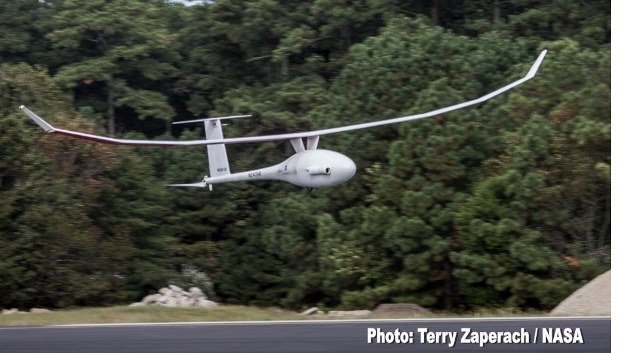
Students had a role in record-breaking test flight
Thursday, November 9, 2017
Four UMES upperclassmen – each with a pilot’s license – etched their names into aviation history this fall by helping track a record-breaking flight of an Unmanned Aerial Vehicle.
Juniors Noah Atkins, Justin Beaudett, Chris Cornett and senior Jean Alectice were part of a team monitoring a five-day, around-the-clock mission for an upstart Falls Church, Va. company that manufactures large drones with long-range flying abilities.
“It was a-once-in-a-lifetime experience,” Alectice said. “I would jump on it again. I had fun doing it.”
From Oct. 18 to Oct. 23, a diesel-powered aircraft with a 36-foot wingspan circled 5,000 feet above NASA’s Wallops Flight Facility in an endurance test that Vanilla Aircraft LLC declared an unqualified success. The company’s “VA-001” flew an estimated 7,000 miles non-stop over 121 hours and 24 minutes – and had enough fuel to continue at least three more days.
When the experimental aircraft landed, it had achieved the distinction of being the “longest unmanned internal combustion powered flight in history,” according to the company.
“As exciting as this milestone is, the flight itself was quite boring,” Vanilla Aircraft chief engineer Neil Boertlein said. “The plane did what it was designed to do and landed ready to go right back into the air again.”
Beaudett had some experience flying small, remote-control drones, but “nothing of this scale. It really opened my eyes about this segment of aviation.”

The VA-001, Vanilla Aircraft says, is capable of carrying “up to 1.1 cubic feet of payload, with a 30-pound weight limit and provides 800 watts of power” and is “built to operate for up to 10 days at altitudes up to 15,000 feet.”
October’s record-breaking mission was the aircraft’s 10th flight.
Through professional connections arranged by UMES aviation science instructor Chris Hartman, four of his students signed on to work alongside Vanilla Aircraft personnel during overnight shifts at an isolated runway for unmanned aircraft.
The experience “was a complete opposite of my schedule,” Cornett said. “I know I drank too much coffee, I can tell you that.”
Cornett and his UMES “co-pilots” echoed Vanilla Aircraft’s Boertlein view that recording data, saving files and ensuring the aircraft remained on its programmed flight path lacked drama.
“I enjoyed it, but it really was boring monitoring the screens,” Beaudett said. “On the positive side, I did get to learn a new auto-pilot system and pick the brains of the guys from Vanilla Aviation.”
For Atkins, “the big thing that stuck out to me was how uneventful it was. However, I saw that as a testament to the company, and the quality of their project.”
Having pilot licenses was a pre-requisite to be considered for the flight team, the students said. They underwent an intense day-long training session to familiarize themselves with the company’s technology.
“That was a big part of the reason I was interested in being part of this,” Atkins said. “When an opportunity (to work alongside aviation professionals) comes along, you have to seize it.”
Cornett said he “saw it as a resume builder and a chance to earn a little gas money. I figured it was a great way to do some networking that might open up opportunities later” after graduation. He’s considering a career as a commercial airline pilot.
Cornett had no previous experience with drones, and came away realizing “the possibilities with UAVs are a lot more extensive than I thought.”
Alectice is licensed to fly Unmanned Aviation Vehicles, but viewed the test flight as a way to bolster his skills. When he graduates this December, he’s looking to earn a master’s degree in propulsion from Embry-Riddle University in Florida.
The students spent their overnight shifts in a recreational vehicle fitted with operational and tracking equipment. Each would occasionally step outside to get fresh air, where they could easily see a red flash from their aircraft above them in the restricted airspace over Wallops.
With minimal light pollution, Cornett saw several streaks overhead that he believes were from an Orion meteor shower astronomers projected for the night skies.
Alectice, a U.S. Army veteran, did two overnight shifts including the final evening before the drone landed. He said had a chance to get experience manipulating the drone to climb and descend in maneuvers around approaching weather.
The flight was completed under funding from the Office of Naval Research, the company said.
“We have begun to fully demonstrate the viability of this ultra-long endurance aircraft system and are anxious to test new payloads and realize capabilities heretofore unimagined,” Vanilla Aircraft CEO Tim Heely said.
The company’s goal for future flights, it said, will be to “demonstrate the capability to carry classified and unclassified payloads, including electro-optical and infrared imagers, synthetic aperture radar and communications nodes. Likely commercial applications include agricultural mapping, disaster zone imaging, cellular network and internet distribution and infrastructure monitoring.”
An Oct. 26, 2017 Vanilla Aircraft LLC press release was a source in the production of this article.

